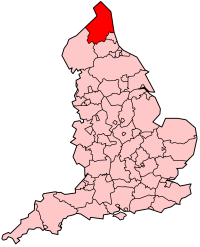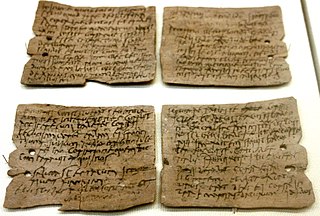
Northumberland, England's northernmost county, is a land where Roman occupiers once guarded a walled frontier, Anglian invaders fought with Celtic natives, and Norman lords built castles to suppress rebellion and defend a contested border with Scotland. The present-day county is a vestige of an independent kingdom that once stretched from Edinburgh to the Humber, hence its name, meaning literally 'north of the Humber'. Reflecting its tumultuous past, Northumberland has more castles than any other county in England, and the greatest number of recognised battle sites. Once an economically important region that supplied much of the coal that powered the industrial revolution, Northumberland is now a primarily rural county with a small and gradually shrinking population.
Lucius Neratius Marcellus was an imperial Roman military officer and senator who held a number of posts in the Emperor's service. Marcellus was elected consul twice, first under Domitian in 95 AD and again under Hadrian in 129. His life provides several examples of how patronage operated in early Imperial Rome.

Housesteads Roman Fort was an auxiliary fort on Hadrian's Wall, at Housesteads, Northumberland, England. It is dramatically positioned on the end of the mile-long crag of the Whin Sill over which the Wall runs, overlooking sparsely populated hills. It was called the "grandest station" on the Wall and is one of the best-preserved and extensively displayed forts. It was occupied for almost 300 years. It was located 5.3 miles west from Carrawburgh fort, 6 miles east of Great Chesters fort and about two miles north east of the existing fort at Vindolanda on the Stanegate road.

Birdoswald Roman Fort was known as Banna in Roman times, reflecting the geography of the site on a triangular spur of land bounded by cliffs to the south and east commanding a broad meander of the River Irthing in Cumbria below.

Eric Barff Birley,, was a British historian and archaeologist, particularly associated with the excavation of the forts of Hadrian's Wall, notably at Vindolanda.

Magnis or Magna was a Roman fort near Hadrian's Wall in northern Britain. Its ruins are now known as Carvoran Roman Fort and are located near Carvoran, Northumberland, in northern England. It was built on the Stanegate frontier and Roman road, linking Coria (Corbridge) in the east to Luguvalium (Carlisle) in the west, before the building of Hadrian's Wall.

The Vindolanda tablets were, at the time of their discovery, the oldest surviving handwritten documents in Britain. They are a rich source of information about life on the northern frontier of Roman Britain. Written on fragments of thin, postcard-sized wooden leaf-tablets with carbon-based ink, the tablets date to the 1st and 2nd centuries AD. Although similar records on papyrus were known from elsewhere in the Roman Empire, wooden tablets with ink text had not been recovered until 1973, when archaeologist Robin Birley, his attention being drawn by student excavator Keith Liddell, discovered some at the site of Vindolanda, a Roman fort in northern England.
Luguvalium was an ancient Roman city in northern Britain located within present-day Carlisle, Cumbria, and may have been the capital of the 4th-century province of Valentia. It was the northernmost city of the Roman Empire.
Robin Edgar Birley was a British archaeologist. He was the Director of Excavations at the Roman site of Vindolanda and head of the Vindolanda research committee. He was the son of Eric Birley and Margaret "Peggy" Birley and brother of Anthony Birley. His wife Patricia Birley, son Andrew Birley, and daughter-in-law Barbara Birley are also published authors on Roman Vindolanda.

Andrew Robin Birley is a British archaeologist and the Director of Excavations on the site of Vindolanda. He is the son of Robin Birley and Patricia Birley and grandson of Eric Birley, who founded the department of Archaeology at Durham University, and of Margaret "Peggy" Birley, and is married to Barbara Birley, also an archaeologist and the Curator of the Vindolanda Trust. He graduated from the University of Leicester in the summer of 1996 and has been working on the site for 18 years, ten of which have been in full-time employment by the Vindolanda Trust.

Coria was a fort and town 2.5 miles (4.0 km) south of Hadrian's Wall, in the Roman province of Britannia. It was strategically located on the junction of a major Roman north–south road with the River Tyne and the Roman Stanegate road, which was also the first frontier line which ran east–west between Coria and Luguvalium. Corbridge Roman Site is in the village of Corbridge in the county of Northumberland.

Bremetennacum,, or Bremetennacum Veteranorum, was a Roman fort on the site of the present day village of Ribchester in Lancashire, England. The site is a Scheduled Monument.

Uxelodunum was a Roman fort with associated civilian settlement (vicus) in modern-day Carlisle, Cumbria, England. It was the largest fort on Hadrian's Wall and is now buried beneath the suburb of Stanwix.
Sulpicia Lepidina was the wife of Flavius Cerialis, prefect of the Ninth Cohort of Batavians, stationed at Vindolanda in Roman Britain in the early 2nd century AD. She is known from her correspondence, including a birthday invitation she received from Claudia Severa.

Milecastle 19 (Matfen Piers) was a milecastle of the Roman Hadrian's Wall. Sited just to the east of the hamlet of Matfen Piers, the milecastle is today covered by the B6318 Military Road. The milecastle is notable for the discovery of an altar by Eric Birley in the 1930s. An inscription on the altar is one of the few dedications to a mother goddess found in Roman Britain, and was made by members of the First Cohort of Varduli from northern Spain. The presence of the Vardulians at this milecastle has led to debate amongst archaeologists over the origins of troops used to garrison the wall. A smaller altar was found at one of the two associated turrets.
Lavatrae , also known as Lavatris, was a Roman fort in the modern-day village of Bowes, County Durham, England. The medieval Bowes Castle was built within the perimeter of the fort.

Brian Dobson was an English archaeologist, teacher and scholar. His specialisms were Hadrian's Wall and the Roman Army. He studied under Eric Birley and is a member of the so-called 'Durham School' of archaeology. He was a Reader Emeritus of Durham University.

Brenda Swinbank was an English archaeologist. She was one of the first women in Britain to become a professional archaeologist, specialising in the study of Hadrian's Wall, and was instrumental in bringing to publication excavations under York Minster.
Barbara Allison Birley is an archaeologist and museum curator working at the Roman fort of Vindolanda, near Hadrian's Wall.
Margaret "Peggy" Isobel Birley, née Goodlet was an archaeologist who worked at the Roman forts of Housesteads and Vindolanda.

























